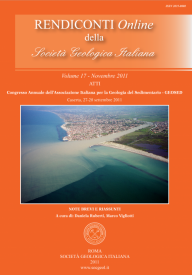
Caratteri geologici e stratigrafi ci del settore esterno dell'Appennino sannitico-irpino (Campania, Italia)
Di Nocera S. (*), Matano F. (*) & Pinto F. (**)
(*) Department of Earth Science, University of Naples "Federico II". E-mail: sildinoc@unina.it; matano@unina.it
(**) Department of Geological and Environmental Sciences, University of Sannio. E-mail: fpinto@unisannio.it
Volume: 17/2011
Pages: 95-98
Abstract
Stratigraphic and geologic features of the external sector of Sannio-Irpinia Apennines (Campania, Italy).
The very complex stratigraphic and tectonic features of the Sannio and Irpinia sectors of southern Apennines (Italy) are described. Facies analysis, stratigraphy, tectonics and geological mapping of the Late Cretaceous to Miocene units allowed us to identify six different tectonic units: the Sannio, Frigento, Fortore, Valle Tammaro, Daunia and Vallone del Toro units, which are strongly deformed and thrust eastward upon the buried Apulian thrust-system. All the basinal deposits are referred to an external basinal domain (Lagonegrese-Molisano Basin). The tectonic units are mainly formed by Upper Cretaceous to Early Miocene successions characterized by basinal and shelf-margin facies (Flysch Rosso Fm) and by basinal mainly calcareous-pelitic deposits of the Argille Variegate Group and Corleto Perticara fm, conformably followed by numidian flysch quartzarenites and arkosic arenites (Fragneto Monforte fm and San Giorgio fm). In
the westernmost areas, the successions are characterized by frequent occurrence of coarse to fi ne calciclastic deposits settled by dense gravity flows (Flysch Rosso Fm) coming from a carbonate platform margin, as well as by slumps; they are followed by upper Burdigalian upper Langhian p.p. numidian flysch quartzarenites. The successions cropping out in the central-eastern zone are typically composed of pelagic sediments (varicoloured clays and shales) intercalated with fine carbonate turbidites and representing a more distal facies than the coarser proximal ones.
The tectonic units are unconformably overlain by middle-upper Miocene terrigenous flysch deposits (Pietra Boiara unit, Reino-Morgia dei Rauli fm, Vallone Ponticello fm, Castelvetere flysch, Villanova del Battista fm, San Bartolomeo Flysch and Caiazzo sandstones), Messinian deposits (Altavilla group) and Pliocene unconformity-boundedmarine to alluvial units (Ariano Irpino supersynthem) referred to wedge-top depozone basins.
The Lagonegro-Molise units of the Sannio-Irpinia Apennines show a very complicated structural style, that results from the Pliocene refolding of more ancient structures produced by middle-late Miocene deformation.
Keywords
Get Full Text